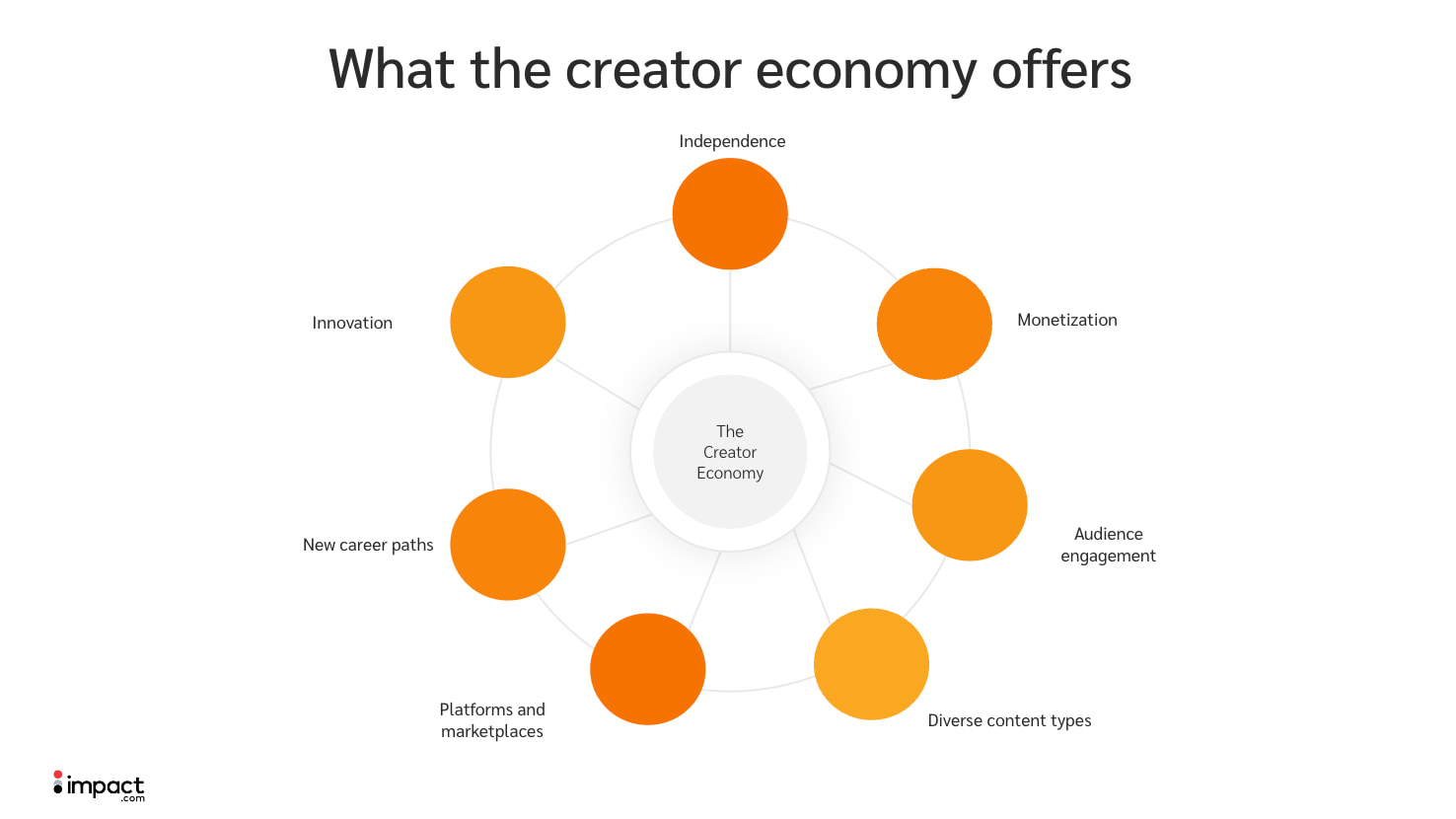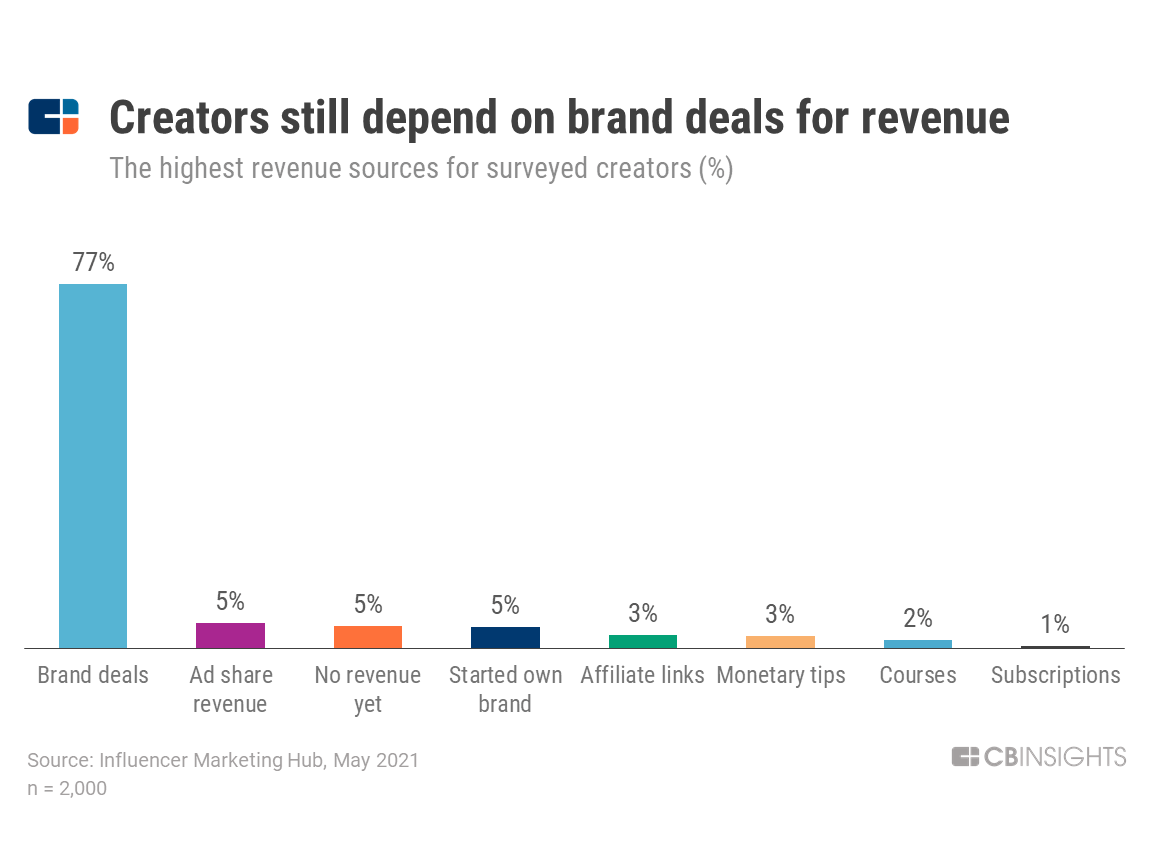The Creator Economy refers to the ecosystem where individuals create and monetize digital content. It includes influencers, bloggers, and digital artists.
The Creator Economy has seen rapid growth in recent years. It allows individuals to earn a living through their creative skills. Platforms like YouTube, Instagram, and TikTok enable creators to reach vast audiences. They can monetize their content through ads, sponsorships, and merchandise.
This economy empowers creators to build personal brands and connect directly with their followers. It democratizes content creation, giving everyone a chance to showcase their talents. The rise of the Creator Economy also fosters niche communities. These communities thrive on unique and engaging content. The future of the Creator Economy looks promising, with endless opportunities for creators.

Credit: impact.com
Introduction To The Creator Economy
The Creator Economy represents a new world for content creators. It is a space where digital creators can share their work and earn money. This modern economy is booming due to digital platforms and social media.
Rise Of Digital Creators
Digital creators are individuals who produce content for online platforms. They create videos, blogs, podcasts, and more. These creators have millions of followers. They share their passions and talents with the world.
Many digital creators earn income through various means. These include:
- Ad revenue
- Sponsored content
- Merchandise sales
- Subscription services
The popularity of these creators is rising rapidly. They have become powerful influencers in today’s market.
Shift From Traditional Media
Traditional media, like TV and newspapers, used to be the main sources of content. Now, digital platforms have taken over. People prefer watching YouTube or TikTok instead of TV.
This shift happened for several reasons:
- Ease of access: Digital content is available anytime, anywhere.
- Cost: Many digital platforms are free or cheaper than traditional media.
- Diversity: There is a wide variety of content to choose from.
Today, digital creators have more influence than many traditional media outlets. This new economy offers endless opportunities for creators and consumers alike.
Key Components
The creator economy thrives on several essential components. These elements drive the growth and success of creators. Below, we explore the key components.
Content Platforms
Content platforms are the backbone of the creator economy. These platforms allow creators to publish and share their work. Popular platforms include:
- YouTube: A video-sharing platform where creators upload videos.
- Instagram: A social media platform for photos and short videos.
- TikTok: A platform for short, engaging video clips.
- Medium: A place for writers to share articles and stories.
- Patreon: A membership platform for exclusive content.
Each platform has unique features and audiences. Creators choose platforms based on their content type and target audience.
Monetization Tools
Monetization tools enable creators to earn from their content. These tools offer various ways to generate income. Some common monetization tools include:
- Ad Revenue: Earnings from ads displayed on content.
- Subscriptions: Monthly fees from fans for exclusive content.
- Merchandising: Selling branded products to fans.
- Affiliate Marketing: Earning commissions by promoting products.
- Donations: Direct contributions from supporters.
Monetization tools help creators sustain their work financially. They offer diverse revenue streams, increasing financial stability.
Revenue Streams For Creators
In the Creator Economy, revenue streams keep the creativity flowing. Creators can make money in many ways. Let’s explore some of these revenue streams.
Ad Revenue
Ad revenue is a common income source for creators. Platforms like YouTube and Twitch pay creators through ads. These ads play before or during their content.
Creators earn money based on views and ad clicks. Here’s a simple breakdown:
| Platform | Ad Type | Payment Model |
|---|---|---|
| YouTube | Video Ads | Cost Per Click (CPC) |
| Twitch | Banner Ads | Cost Per Mille (CPM) |
Sponsored Content
Sponsored content is another lucrative way for creators to earn. Brands pay creators to promote their products. This can be through videos, blogs, or social media posts.
Here are some common ways creators engage in sponsored content:
- Product Reviews
- Unboxing Videos
- Social Media Posts
Brands look for creators with a strong, engaged audience. The more followers you have, the more you can earn from sponsored content.
.png)
Credit: www.signalfire.com
Direct Support From Fans
The Creator Economy thrives on the direct support from fans. Fans provide financial backing to their favorite creators. This backing sustains creators and fuels their projects. Let’s explore two popular ways fans offer support.
Crowdfunding
Crowdfunding is a way for creators to raise money for their projects. Fans contribute small amounts to help reach a bigger goal. This method can fund creative projects, new products, or community events. The platform Kickstarter is a good example of this model.
| Platform | Purpose | Example |
|---|---|---|
| Kickstarter | Creative Projects | Films, Games, Art |
| GoFundMe | Personal Causes | Medical Bills, Education |
- Creators set a funding goal.
- Fans pledge money to support the project.
- If the goal is met, the project gets funded.
Subscription Models
Subscription models offer another way for fans to support creators. Fans pay a monthly fee to access exclusive content. Platforms like Patreon and OnlyFans use this model.
- Creators offer different subscription tiers.
- Each tier provides different levels of access and perks.
- Fans choose a tier that fits their budget.
Subscription models ensure a steady income for creators. This helps them focus on creating more content for their fans.
Both crowdfunding and subscription models are key to the Creator Economy. They allow creators to connect with their fans and build sustainable careers.
Merchandising And Products
The Creator Economy is booming, and merchandising and products are key parts of it. Creators can make money by selling physical and digital products. This helps them connect with fans and grow their brand.
Branded Merchandise
Branded merchandise includes items like t-shirts, hats, and mugs. Creators can put their logos or catchphrases on these products. This helps fans feel closer to their favorite creators.
- T-shirts: Fans love wearing shirts with cool designs.
- Hats: Caps with logos are popular and stylish.
- Mugs: Coffee mugs with fun sayings make great gifts.
Using branded merchandise, creators can build a loyal fan base. These items are also great for promoting the creator’s brand.
Digital Products
Digital products are another way for creators to earn money. These include e-books, online courses, and exclusive content. Digital products are easy to make and distribute.
- E-books: Creators can write books on their expertise.
- Online courses: Teaching skills through video lessons is popular.
- Exclusive content: Fans pay for special access to unique content.
Digital products offer high profit margins. They also allow creators to share their knowledge with the world.
Both branded merchandise and digital products are crucial in the creator economy. They help creators monetize their content and engage with their audience.

Credit: www.cbinsights.com
Brand Collaborations
The Creator Economy thrives on brand collaborations. These collaborations benefit both creators and brands. They provide creators with revenue opportunities. Brands gain access to engaged audiences. Below, we explore two key types of brand collaborations.
Influencer Marketing
Influencer marketing is powerful in the Creator Economy. Influencers promote products to their loyal followers. This boosts brand visibility and trust. Influencers often share:
- Product reviews
- Tutorials
- Unboxing videos
These posts are engaging and authentic. They often include special discount codes. This encourages followers to purchase.
Affiliate Partnerships
Affiliate partnerships are another key strategy. Creators earn a commission on sales. They share unique affiliate links. These links track purchases made by followers. This is a win-win for both parties.
Here is how affiliate partnerships work:
- Creators join an affiliate program.
- They promote products through their content.
- Followers click on affiliate links.
- Purchases are tracked and commissions are earned.
Affiliate partnerships offer a steady income stream. They also help brands reach new audiences.
Challenges And Opportunities
The Creator Economy offers many opportunities. Yet, it also presents unique challenges. This section will explore these aspects in detail.
Market Saturation
The Creator Economy is growing fast. Many people now create content. This leads to market saturation. It becomes hard for new creators to stand out.
Here are some challenges of market saturation:
- More competition in every niche
- Hard to attract audience attention
- Lower chances of going viral
Despite these challenges, there are opportunities:
- Collaborating with other creators
- Finding underserved niches
- Creating high-quality, unique content
Evolving Platforms
Platforms like YouTube and TikTok change often. New features and algorithms impact creators. Keeping up with these changes is tough.
Creators face these challenges with evolving platforms:
- Algorithms can change anytime
- New features require learning
- Platform policies may affect revenue
Yet, these changes also bring opportunities:
- Early adoption of new features
- Leveraging algorithm changes
- Diversifying across multiple platforms
Understanding the challenges and opportunities in the Creator Economy is crucial. It helps creators navigate this ever-changing landscape effectively.
Future Of The Creator Economy
The future of the creator economy looks bright. It’s evolving fast. New technologies and business models drive this change. Creators find more ways to succeed.
Technological Innovations
Technology helps creators grow. Artificial Intelligence (AI) tools make content creation easier. AI can edit videos, write scripts, and even create music.
Virtual Reality (VR) and Augmented Reality (AR) offer new experiences. Creators use VR to make immersive videos. AR adds digital elements to the real world.
Blockchain technology ensures fair payment. Creators get paid directly. No middlemen are involved. This boosts trust and transparency.
New Business Models
New business models support creators. Subscription services allow fans to pay monthly. Creators get steady income. Platforms like Patreon and OnlyFans use this model.
Crowdfunding helps creators start big projects. Sites like Kickstarter and GoFundMe make this possible. Fans fund the projects they love.
Merchandising is another model. Creators sell branded products. This can be t-shirts, mugs, or anything else. It helps them earn more.
Here is a table summarizing the new business models:
| Business Model | Description | Examples |
|---|---|---|
| Subscription Services | Fans pay monthly fees | Patreon, OnlyFans |
| Crowdfunding | Fans fund projects | Kickstarter, GoFundMe |
| Merchandising | Sell branded products | T-shirts, Mugs |
Frequently Asked Questions
Who Makes Up The Creator Economy?
The creator economy consists of influencers, bloggers, vloggers, podcasters, artists, musicians, and social media content creators.
Can You Make A Living In The Creator Economy?
Yes, you can make a living in the creator economy. Success depends on your niche, audience, and content quality. Consistent effort and engagement are crucial.
What Is Happening In The Creator Economy?
The creator economy is booming, with more influencers monetizing content through diverse platforms. Brands increasingly collaborate with creators. Blockchain and NFTs offer new revenue streams.
What Is The Creator Driven Economy?
The creator-driven economy allows individuals to monetize their content, skills, and influence directly. Creators earn through sponsorships, merchandise, subscriptions, and more. This economy empowers independent creators to thrive financially without relying on traditional media platforms. It leverages social media and digital platforms for income generation.
Conclusion
The Creator Economy is reshaping how individuals monetize their skills and passions. It offers endless opportunities for creativity and income. Embrace this trend to explore new career paths and financial independence. Stay updated and leverage the tools available to thrive in this dynamic ecosystem.
The future is bright for creators everywhere.